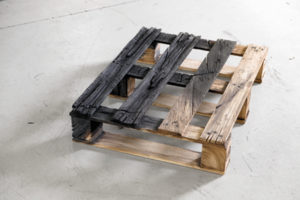Urban Platform burned
Valeria Vaccaro
 2018
2018
White Carrara marble, ink
80 cm x 60 cm x 15 cm
“Urban Platform burned” by Valeria Vaccaro is seemingly a ready-made: a used and singed EUR-pallet, which has even the trademark of the European Pallet Association (EPAL). Nevertheless, the size is different. The standardised tool for goods transportation is 120 cm x 80 cm x 14.4 cm, while the presented one is significantly smaller. Even the proportions are inexact. Nonetheless, we recognise the article of daily use at once. However, the sculpture is not a simple transfer of an everyday object into art, due to its material.
Far from being a structure made of wood, “Urban Platform burned” is a marble sculpture, executed in a hyper-realistic manner. The brand stamp of the EPAL trademark and the singed sector seem to confirm the wooden materiality. It is almost incredible that the pretended, warm and soft matter should be cold and hard stone. Technically perfect, Valeria applies the effect of trompe-l’oeil, to deceive the observer who even neglects the different dimensions, due to the impeccable illusion.
One of the attractions of the sculpture is connected to the contrast between the true material and the simulated one. Marble is an eternal material, a stone, which can be transformed only by force. Whereas wood is more ephemeral and has various forms of existence. Starting as a growing plant, it becomes to be a tree and has various possibilities of usage afterwards. Especially when getting in contact with fire it is very evanescent and changes into another stage: wood charcoal or the even more volatile ashes.
Valeria underlines this transience in her sculpture. She catches this very fleeting and special moment of transformation, when the wood is burned. The pallet is no longer unharmed, the fire is already extinct, but the process of disintegration has not started yet. Thus, this instant becomes eternal. Here, the fire is not destructive, but a metaphor for renewal, since it highlights a particular point in time and transfers an ordinary EUR-pallet into an artwork.
By the choice of the prestigious Carrara marble, Valeria continuous the tradition of renowned artists, who transformed this material into world-famous sculptures, like Michelangelo’s David. Although the Greek didn’t used this particular stone, they could be exemplary in another way. The antique sculpture of Laocoon and His Sons depicts a special, ephemeral moment: the priest with his sons in the instant of highest agony. The ideal of the Laocoon Group and other antique sculptures was highly recognised in the Renaissance. However, in contrast to the ancient masters, the Renaissance and Mannerism artists left their oeuvres white, whereas the antique sculptures were originally painted. At this point, Valeria follows the ancient practise.
Nevertheless, by the choice of the subject, the artist is far distant from her classical predecessors. The depicted topic is not one from antique legends or biblical stories; it is an article of daily use. The EUR-pallet accrued in 1961, due to a contract of the European railways for the standardisation and with that the facilitation of the loading process. Since then billions of them travelled Europe. In the meantime, discarded pallets are upcycled and used as basic material for furniture. Actually, it is possible to buy preassembled furniture made of them or pieces that only simulate the aesthetic. Even producers of the luxury segment rely on the idea of EUR-pallets.
There are two points in common with the original purpose and also the advanced use of the EUR-pallets and the Carrara marble. On one hand, the standardised transport tool, travels far like the precious stone. Additionally, the EUR-pallet enters the world of design by its new usage, as the Carrara marble does since the end of the Roman Republic. It is appropriated as house equipment, often artistically elaborated. Moreover, it is the material for many artworks. Sooner or later, even the EUR-pallet might be used in this sense or is it already? With Valeria’s creation, the trivial transport tool has entered the world of art, although only by its form and not by the original feedstock.
Valeria Vaccaro
Born in 1988 in Turin, Italy, Valeria Vaccaro went to the Fine Arts High School in her hometown. Then, she studied sculpture at the Accademia di Belle Arti also in Turin. Early, in 2005 she presented her works to the public. Since this time, she participated in many group shows and art fairs, primarily in Italy. With the itinerant Biennale Jeune Création Européenne (JCE) from 2013 to 2015, her creations travelled throughout Europe, with shows in France, the Netherlands, Germany, Lithuania, the Slovakia, Hungary, Austria, Spain and Portugal. She won a special mention from the city of Turin for the occasion of the 2017 Art Prize CBM.
Valeria explores in her hyper-realistic oeuvre fire and combustion, even though she only depicts the impact and does not work directly with the often destructive element. For her, fire is rather a purifying matter of inspiration, which transforms material. Interesting from this point of view is that her feedstock is a relatively fire resistant one: Carrara marble.
The artist transforms the white stone into seemingly other materials. Often she features items of everyday use, such as candles, matches, transport boxes, furniture or as in our artwork of the month / November 2019 EUR-pallets. By processing the marble and painting it afterwards, emerge objects that portray the models perfectly. Common to these natural reproductions is that they carry traces of combustion, but the flame remains invisible. Herewith, she freezes a single instant between ideal condition and disintegration, to deliver it to eternity. A special appeal in these sculptures lies in the contrast of the simulated materiality and the real one.
Valeria lives and works in Turin.
